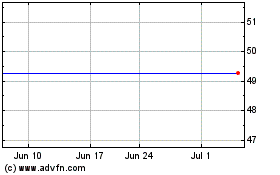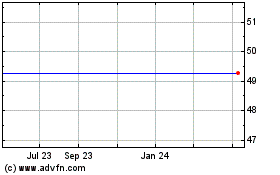Robo Adviser Wealthfront Begins to Offer Free Portfolio Reviews
January 13 2016 - 2:00PM
Dow Jones News
In a bid to attract more assets, Wealthfront Inc. is joining
other robo advisers in providing free advice to investors about
their accounts at other financial institutions.
On Wednesday, the four-year-old startup launched Wealthfront
Portfolio Review, a service that recommends ways to improve
diversification and reduce fees in accounts at nine brokerage
firms, including Charles Schwab Corp., Fidelity Investments and the
Merrill Lynch unit of Bank of America Corp.
The goal, says Wealthfront CEO Adam Nash, is "to help people
answer the question, 'Am I invested the right way?' "
In the process, of course, the Redwood City, Calif., firm hopes
to entice more people to hire it to manage their money. Currently,
Wealthfront—with about $3 billion in assets under
management—charges nothing to oversee the first $10,000 a client
brings it and 0.25% a year above that threshold.
Such free evaluations function as "lead generation" tools for
other robo advisers, said Alois Pirker, research director at market
research firm Aite Group, who specializes in wealth management.
While investors can always implement the recommendations they
receive on their own, the firms hope to get authorization to manage
some or all of the assets they get a look at.
But only a fraction of the users of these services have become
paying customers. For example, while investors use Personal Capital
Corp.'s software to track over $200 billion in investment accounts,
the firm manages $1.9 billion, said Mark Goines, chief marketing
officer. "We're very happy about the conversions we get," he
said.
Two months ago, Betterment LLC—which manages $3.2 billion—began
offering a way for investors to link their 401(k), individual
retirement accounts and brokerage accounts to its free RetireGuide
service, which provides advice on how much to save and how to
invest for retirement. SigFig Wealth Management LLC, with an
estimated $100 million under management, has offered a free
portfolio-evaluation service for the past year, says Tomas Pueyo,
vice president of growth. Personal Capital and Jemstep have had
similar services for about three years.
Jemstep's free service has given investors "an opportunity to
understand the benefit of advice," said Simon Roy, president of the
Los Altos, Calif., company. Jemstep, which has mainly sold its robo
technology to financial advisers, was acquired on Tuesday by
asset-management firm Invesco Ltd. for an undisclosed price.
Wealthfront said it expects its new service to help it triple
the number of people who sign up for its asset-management service
this month, in comparison with January 2015.
The portfolio-review service is more limited than those of some
rivals. For example, Personal Capital's recommendations can
encompass 401(k)s, IRAs and 529 college savings plans as well as
brokerage accounts, said Mr. Goines. In contrast, Wealthfront
evaluates only brokerage accounts, although it plans to "add
retirement accounts over time," Mr. Nash said.
Wealthfront Portofio Review starts by asking prospective clients
to fill out a questionnaire. In addition to income, age, and
savings, the questions assess investors' feelings about market
volatility, says Mr. Nash. Users supply the usernames and passwords
of their brokerage accounts. The other firms on the list of nine
are Vanguard Group, E*Trade Financial Corp., TD Ameritrade Corp,
Scottrade Inc., Morgan Stanley, and Wells Fargo & Co.
Users receive a report analyzing their asset allocations and the
investment-related and advisory fees and commissions they pay. If
total fees are above 0.5% of assets, the report identifies the
funds with high fees.
In an analysis of the thousands of portfolios clients
transferred to Wealthfront in 2015, the firm found that 92% had at
least one problem, said Mr. Nash. For example, he said, more than
one-third had more than 10% of their assets in cash, an allocation
that can substantially reduce returns over time.
Wealthfront also calculates how much investors will pay in taxes
if they sell assets to purchase the low-cost exchange-traded funds
it recommends, and it estimates a "payback period" over which they
might recoup those costs through higher returns.
(END) Dow Jones Newswires
January 13, 2016 13:45 ET (18:45 GMT)
Copyright (c) 2016 Dow Jones & Company, Inc.
E TRADE Financial (NASDAQ:ETFC)
Historical Stock Chart
From Mar 2024 to Apr 2024

E TRADE Financial (NASDAQ:ETFC)
Historical Stock Chart
From Apr 2023 to Apr 2024
